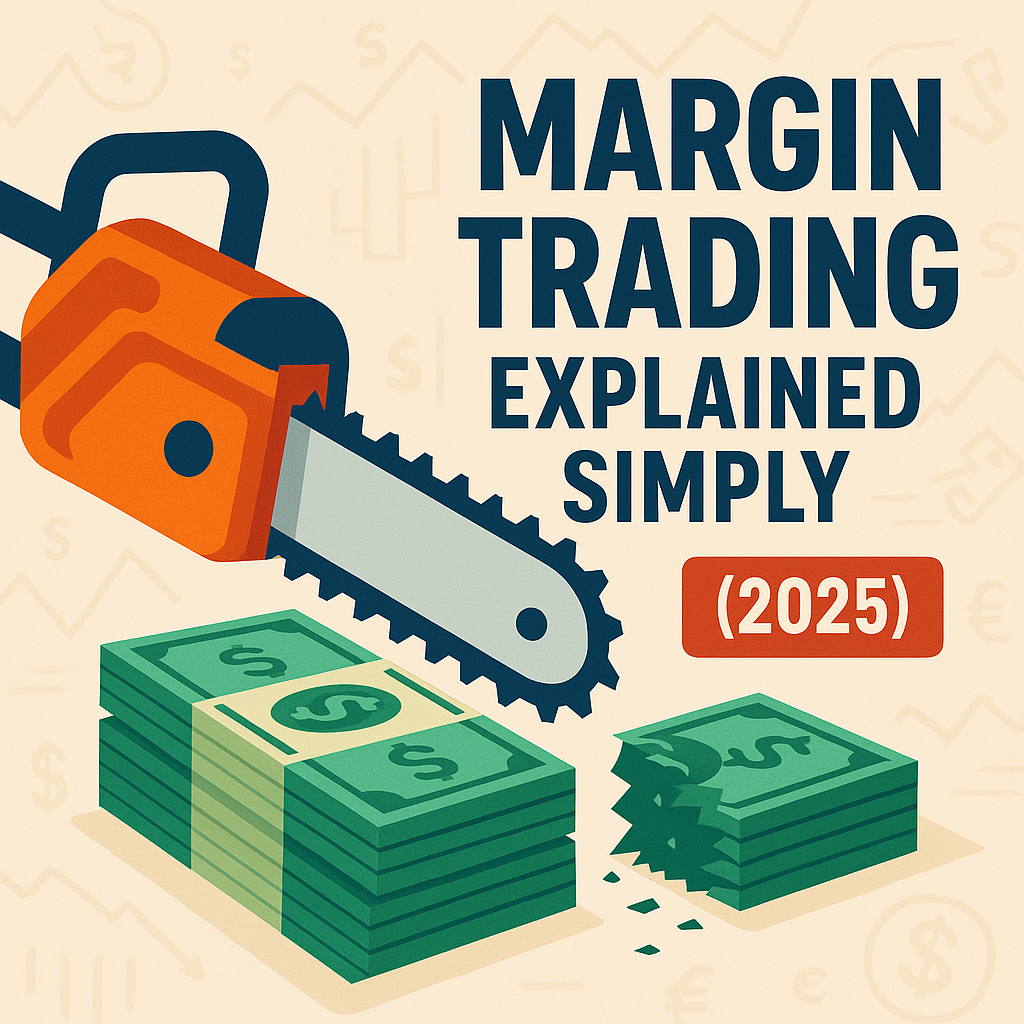Margin trading is like alcohol – a little bit can make the party more fun, too much will ruin your life, and some people shouldn’t touch it at all. I learned this after getting margin called three times, losing $50,000, and nearly destroying my marriage. But then I learned to use margin properly and turned $75,000 into $275,000 during the 2020-2021 rally. Let me explain exactly how margin works, why it’s so dangerous, and how to use it without ending up living in your car.
Here’s what nobody tells you about margin: your broker is not your friend. They’re a drug dealer offering you leverage cocaine, and they make money whether you win or lose. They’ll give you 2:1, 4:1, sometimes 6:1 leverage with a smile, knowing that 90% of margin traders will blow up their accounts. The broker always gets paid first, and if you can’t pay, they’ll liquidate your positions at the worst possible prices and send you a bill for the difference.
But here’s the other thing nobody admits: used correctly, margin is how the wealthy get wealthier. Every hedge fund uses margin. Every professional trader uses margin. The difference is they understand the rules, the risks, and most importantly, when NOT to use it. After losing enough money to buy a Tesla, I finally figured it out, and I’m going to save you the same expensive education.
What Margin Trading Actually Is (Not the BS Definition)
The Textbook Definition
Margin trading is borrowing money from your broker to buy more securities than you could with just your cash. You’re using leverage to amplify your buying power.
The Real Definition
Margin trading is taking out a high-interest loan from a legal loan shark to gamble with, where the collateral is your entire portfolio, and they can sell everything you own without asking if you can’t pay up.

Get a VPS from as low as $11/year! WOW!
How It Actually Works
Without Margin:
- You have: $10,000 cash
- You can buy: $10,000 worth of stock
- Stock goes up 10%: You make $1,000 (10% return)
- Stock goes down 10%: You lose $1,000 (10% loss)
With 2:1 Margin:
- You have: $10,000 cash
- You can buy: $20,000 worth of stock
- Stock goes up 10%: You make $2,000 (20% return)
- Stock goes down 10%: You lose $2,000 (20% loss)
- Stock goes down 50%: You lose everything and owe the broker
That last line is what they don’t emphasize in the marketing materials.
My First Margin Call (The $30,000 Lesson)
March 2020. I had $100,000 in my account and used margin to buy $200,000 worth of “bargain” stocks during the crash. “I’m buying the dip!” I told my wife. “I’m using other people’s money to get rich!”
Day 1: Portfolio value: $200,000 (feels like a genius)
Day 2: Market drops 5%, portfolio: $190,000 (no problem)
Day 3: Market drops 7%, portfolio: $176,700 (getting nervous)
Day 4: Market drops 8%, portfolio: $162,564 (margin call)
The Margin Call:
“Dear valued client, your account is below maintenance requirements. Please deposit $30,000 by 12 PM or we will liquidate positions to meet requirements.”
I didn’t have $30,000. They liquidated my positions at the absolute bottom. Lost $30,000 in four days. Market recovered two weeks later. I wanted to throw my computer through the window.
The Types of Margin (And Which Will Kill You)
Cash Account Margin
- No margin, trade with your money only
- Can’t lose more than you have
- For humans with self-control issues
Regulation T Margin (Standard)
- 2:1 leverage for stocks
- 4:1 for day trading
- Most common type
- Initial requirement: 50% of purchase price
- Maintenance requirement: 25% equity
Example: Buy $10,000 of Apple
- You pay: $5,000
- Broker loans: $5,000
- If Apple drops to $6,666, margin call
Portfolio Margin (The Weapon of Mass Destruction)
- Up to 6:1 leverage
- Based on risk, not fixed ratios
- Requires $100,000+ account
- For “sophisticated” investors (idiots with money)
My Portfolio Margin Disaster:
Had $150,000, leveraged to $900,000 position. One bad day: margin call for $200,000. Couldn’t pay. Entire account liquidated. Gone. All of it.
Futures Margin (Different Beast)
- Can be 10:1 or higher
- Mark-to-market daily
- Can go negative (you owe broker)
- Not covered here (different article needed)
How Margin Interest Actually Works (The Hidden Killer)
Nobody talks about margin interest rates. They’re criminal.
Current Margin Rates (2025)
Interactive Brokers: 6.83% (the good guy)
TD Ameritrade: 13.25%
Charles Schwab: 13.575%
E*TRADE: 13.95%
Robinhood: 13% (with Gold)
Fidelity: 12.575%
The Real Cost Example
Borrow $50,000 at 13% for one year:
- Interest cost: $6,500
- Need 13% gain just to break even
- Market averages 10% annually
- You’re already losing
My Interest Reality Check:
- 2021: Borrowed average $100,000
- Interest rate: 11%
- Annual interest paid: $11,000
- Could’ve been a nice vacation
How They Calculate It
Daily interest = (Margin balance × Annual rate) ÷ 360
Example: $50,000 margin at 12%
- Daily interest: $16.67
- Monthly: $500
- Quarterly: $1,500
It adds up faster than you think.
The Margin Requirements That Change Everything
Initial Margin Requirements
Stocks: 50% (you pay half)
ETFs: 50%
Mutual Funds: 50%
Options: 100% (can’t use margin)
Penny Stocks: 100% (no margin allowed)
IPOs: 100% for first 30 days
Maintenance Margin Requirements
Most Stocks: 25% equity minimum
Volatile Stocks: 35-50%
Leveraged ETFs: 60-90%
Meme Stocks: Often 100% (no margin)
What This Means:
Buy $10,000 of normal stock with margin:
- You pay: $5,000
- Broker loans: $5,000
- Stock drops to $6,666 = Margin call
- Must have 25% equity ($1,666) minimum
Special Maintenance Requirements (The Gotchas)
My GME Nightmare:
- January 2021: GME maintenance was 25%
- Stock goes parabolic
- Broker changes maintenance to 100% overnight
- Instant margin call on winning position
- Forced to sell at $100 (it went to $400)
Brokers can change requirements ANYTIME. Usually when it screws you most.
How to Calculate Your Margin Buying Power
The Basic Formula
Buying Power = (Cash + Marginable Securities) × 2 – Current Positions
Example:
- Cash: $10,000
- Stocks owned: $20,000
- Total equity: $30,000
- Buying power: $60,000
- Already used: $20,000
- Available: $40,000
The Maintenance Excess Formula
Maintenance Excess = Account Value – (Margin Debt × Maintenance Requirement)
Example:
- Account value: $100,000
- Margin debt: $50,000
- Maintenance requirement: 25%
- Minimum equity needed: $16,667
- Your equity: $50,000
- Excess: $33,333
The Margin Call Formula
Margin Call Price = Margin Debt ÷ (1 – Maintenance Requirement)
Example:
- Bought $20,000 stock with $10,000 margin
- Maintenance requirement: 25%
- Margin call at: $10,000 ÷ 0.75 = $13,333
- Stock drops 33% = Margin call
When Margin Makes Sense (Rarely)
Scenario 1: Short-Term Opportunities
Market crashes, obvious bargains everywhere, but paycheck comes in 2 weeks.
Example: March 2020 (if timed right)
- Borrow $20,000 for 2 weeks
- Buy oversold blue chips
- Cost: $20,000 × 11% × (14/365) = $84
- Potential gain: 10-20% bounce = $2,000-4,000
Scenario 2: Covered Call Enhancement
Own stock, sell calls, use premium to buy more shares on margin.
My Strategy:
- Own 1000 shares of AT&T
- Sell calls for $500/month
- Use $500 to pay margin interest
- Buy additional shares with margin
- Self-funding leverage
Scenario 3: Arbitrage Opportunities
Different prices in different markets (rare but happens).
Real Example:
- Stock trading $50 NYSE, $51 international
- Buy NYSE with margin, sell international
- Lock in $1 spread
- Return margin same day
Scenario 4: Bridge Financing
Need money for few days while waiting for settlement.
Example:
- Sold house, closing in 5 days
- Great investment opportunity today
- Use margin for 5 days
- Cost: Minimal
- Opportunity: Captured
When Margin Will Destroy You (Usually)
Never Use Margin For:
1. Penny Stocks
- Can’t even use margin on most
- Too volatile
- Go to zero frequently
2. Options
- Already leveraged
- Can’t use margin anyway
- Double leverage = death
3. Earnings Plays
- Binary events
- Gaps against you = instant margin call
- Learned this with Netflix
4. Declining Stocks
- “Averaging down” with margin
- Catching falling knives with borrowed money
- How I lost $30,000 on GE
5. Crypto
- 50% daily swings
- 24/7 trading
- Can get margin called while sleeping
6. IPOs
- No margin for 30 days anyway
- Too volatile
- Lockup expirations kill you
My Current Margin Rules (Written in Blood)
After losing $50,000 to margin calls, here are my rules:
Rule 1: Maximum 20% Margin Usage
- Account value: $200,000
- Maximum margin: $40,000
- Usually use: $0-20,000
Rule 2: Only Blue Chip Stocks
- No small caps
- No biotechs
- No meme stocks
- Only profitable companies
Rule 3: Maximum 30 Day Holdings
- Margin isn’t for investing
- It’s for trading
- Long-term margin = guaranteed disaster
Rule 4: 10% Stop Loss on All Margin Positions
- Stock drops 10% = Sell
- No exceptions
- No “it’ll come back”
Rule 5: No Margin in Volatile Markets
- VIX above 30 = No margin
- Bear market = No margin
- Uncertainty = No margin
Rule 6: Always Keep 50% Cash Buffer
- Prevents forced liquidation
- Allows buying opportunities
- Peace of mind
The Hidden Costs of Margin Trading
Cost 1: Interest (Obviously)
- 10-13% annually
- Compounds daily
- Never stops
Cost 2: Forced Liquidations
- Sold at worst prices
- No control over timing
- Usually massive losses
Cost 3: Opportunity Cost
- Can’t hold through downturns
- Miss recoveries
- Forced to sell winners
Cost 4: Stress and Health
- Checking account constantly
- Can’t sleep
- Relationship problems
- Actual health issues
Cost 5: Tax Implications
- Forced sales create taxable events
- Often short-term gains (higher tax)
- No control over timing
My 2021 Tax Disaster:
- Forced liquidations: $150,000 in gains
- Tax bill: $45,000
- Had to sell more to pay taxes
- Death spiral
How to Use Margin Successfully (If You Must)
The Professional Approach
1. Position Sizing
- Never more than 30% margin
- Each position max 5% of total
- Diversify across sectors
2. Risk Management
- Stop losses on everything
- Daily risk assessment
- Weekly margin review
3. Interest Management
- Factor into all calculations
- Pay down regularly
- Switch to cheapest broker (IBKR)
4. Market Timing
- Only in confirmed uptrends
- Never in bear markets
- Reduce in uncertainty
My Successful Margin Trade
November 2020:
- Account: $75,000
- Saw opportunity in recovery stocks
- Borrowed $50,000 (conservative)
- Bought airlines, cruises, banks
- Held 3 months
- Gain: $45,000
- Interest paid: $1,375
- Net profit: $43,625
Keys to success:
- Clear trend
- Reasonable leverage
- Quick execution
- Disciplined exit
The Margin Call Survival Guide
When (not if) you get margin called:
Option 1: Deposit Cash
- Best option if available
- Maintains positions
- No forced sales
Option 2: Sell Positions
- Sell losers first (tax loss)
- Keep winners
- Reduce margin usage
Option 3: Transfer Securities
- From another account
- Increases collateral
- Avoids cash requirement
Option 4: Negotiate (Sometimes)
- Call broker immediately
- Explain situation
- Sometimes get extension
- Don’t count on it
What Actually Happens
My Real Margin Call:
9:00 AM: Email “Margin Call – Action Required”
9:01 AM: Panic
9:05 AM: Check account
9:10 AM: Call broker
10:00 AM: Try to deposit
11:00 AM: Can’t get money in time
12:00 PM: Forced liquidation begins
12:15 PM: Positions sold at terrible prices
2:00 PM: Account cleared, massive losses
2:01 PM: Depression
Alternatives to Margin Trading
Options Leverage
- Defined risk
- Can’t lose more than premium
- No margin calls
- Often better risk/reward
LEAPS Instead of Margin
- Buy long-term calls
- Similar leverage
- No interest payments
- Can’t get margin called
Leveraged ETFs
- Built-in leverage
- No margin needed
- Daily rebalancing (problem)
- Better for short-term
Small Position Sizing
- Trade smaller
- No leverage needed
- Sleep better
- Live longer
The Bottom Line on Margin Trading
Margin trading is a tool, like a chainsaw. Used properly by someone who knows what they’re doing, it’s incredibly powerful. Used carelessly, you’ll cut your fucking leg off.
After losing $50,000 learning how margin works, then making $200,000 using it properly, here’s my advice:
If you’re new: Don’t use margin for at least 2 years. Learn to trade with your own money first.
If you’re profitable: Use maximum 20% margin in strong uptrends only.
If you’re struggling: Never use margin. It amplifies losses more than gains.
If you’re emotional: Stay away completely. Margin + emotions = bankruptcy.
The brokers want you to use margin. They make money on interest and commissions whether you win or lose. The financial media glorifies leverage and big gains. Nobody talks about the guy who lost his house to a margin call.
Use margin like you’d use prescription painkillers – sparingly, carefully, and only when absolutely necessary. Because just like painkillers, margin feels great at first, but addiction will destroy your life.
Remember: You can’t get margin called if you don’t use margin. And sleeping soundly is worth more than leveraged gains that might never come.







